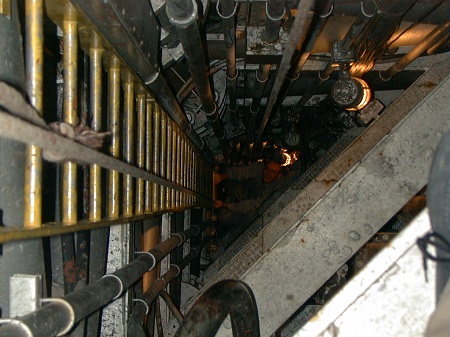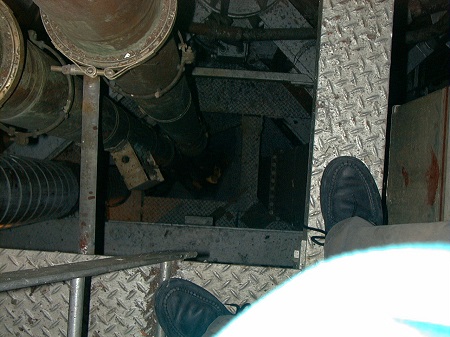Transmission From Tall Buildings: Q&A with Doug Lung
ALEXANDRIA, VA.—Doug Lung has a long history in the television industry as an engineer and writer. He has worked for NBC and Telemundo since 1985, rising to his current position as the vice president of technology for NBC Stations' western region.
Doug's popular columns and articles in TV Technology magazine (a sister publication to Broadcast Engineering Extra) stretch back more than 25 years, and his calm insight into transmission concepts helped many readers work through the issues during broadcast's transition to digital 10 years ago. Doug agreed to answer some questions about his experience installing transmitters and antennas in tall buildings, such as the World Trade Center (new and old), the Empire State Building and the John Hancock Building in Chicago.

WNBC needed to install auxiliary panel antennas on the outside of the mast on the original World Trade Center in NYC.BE Extra: What are some of the key factors in a successful transmitter installation in a tall building? What item needs to be addressed first?
Lung: The first thing to consider is whether the tall building you are looking at has the infrastructure to support the installation you are planning, both for the antenna and the transmitter. Some of the critical items include the amount of power available, power reliability, transmitter cooling options and options for emergency power. One of the challenges broadcasters in New York City faced after 9/11 was getting enough power to the upper floors of the Empire State Building where the transmitters would be located.
BE Extra: Why is it important to work with contractors who already know the building? Can't a good engineering company get the necessary information from blueprints or a site inspection?
Lung: Blueprints usually don't show existing transmission line runs in the building and, depending on the age of the building, may not show other impediments to connecting the output of the transmitter to the input of the antenna. The other consideration is what, for lack of a better term, I'll call "building culture." Unlike a ground-based transmitter room, a location on top of a high-rise is going to involve dealing with other tenants, some of whom won't be broadcasters, and with management that is as concerned about the welfare of the other high-priced top-floor tenants as they are with your desire to put a 500 kW generator on the floor above a lawyer's office. Having a contractor who knows the "building culture" will save you a lot of time and money. On one of the two top high-rises in a major city I won't mention, I had a need to get a satellite dish to the roof. It wouldn't fit through the doors to the roof. I hired a contractor who did a lot of work in the building and he was able to work out a deal with the restaurant a floor or few below to hoist the dish up from the restaurant's patio early one morning.

Access to WNJU's antenna on top of the original World Trade CenterBE Extra: Is it reasonable to estimate the installation costs up front and stick to the budget? What are a couple of the budget busters you've seen?
The professional video industry's #1 source for news, trends and product and tech information. Sign up below.
Lung: My experience working with tall buildings is to take your best guess estimate based on quotes and double it. It sounds extreme, but in a major urban area where work often has to be done overnight when workers are being paid double time for a full day when only working four hours, costs add up. If you can't get the antenna tuned or the work completed, you're looking at another night. Things always crop up that you don't expect. Even inside work can be challenging. After spending a few days working on a transmission line run you may find there is a space that an eight-inch line just won't fit through and you have to start over.
BE Extra: How do you keep the transmitter and associated gear cool? Are there any special issues in skyscrapers?
Lung: Ground-based transmitters can put a heat exchanger on a pad outside and be done with it. Using heat exchangers in a high-rise isn't as easy because of the air flow around the building. You might not be able to install a fan big enough to pull enough air over your heat exchanger to keep your transmitter happy. Air-cooled transmitters can be a problem for the same reason. One UHF analog station in Chicago had to resort to running tap water through its transmitter to cool it and then dump the water down a drain. As you can imagine, that was incredibly expensive. Not surprisingly, that station was also one of the first, if not the first, to deploy a high-power air-cooled klystrode transmitter. The simplest option, if it is available, it to use the building's HVAC condenser water. Make sure the pumps aren't turned off on weekends. On a recent installation in the John Hancock building in Chicago, I was surprised at the large amount of junk in the water. Fortunately the station had installed an extensive filtering system. A water-to-water heat exchanger is a must to keep this junk from getting into the transmitter.

Access space for WNJU's and WXTV's transmission line was cramped on the original World Trade Center.BE Extra: How about installing microwave dishes? Inside? Outside?
Lung: You'll find different buildings have different options for microwaves. At Willis Tower in Chicago, stations usually aim their microwaves out a window, making deals with other stations and building management to use different windows if they don't have ones facing the right direction. Other buildings may have outside space for microwave dishes. One thing to keep in mind for ENG receive antennas is that placing one lower on the side of the building is better than installing it low on a tower near the center of the building's roof. For a building with large roof, like the original World Trade Center, the roof prevented use of the ENG antenna for shots close to the building.
BE Extra: Will any antenna design work or might there need to be compromises for aesthetic, engineering and/or installation reasons?
Lung: Ideally, you would like the antenna to be on the top with no obstructions. If you aren't one of the first tenants on the top of a high-rise, compromises are likely. For example, I designed one antenna system for the Empire State Building that uses a primary antenna to serve the primary coverage area from one side of the mooring mast, but adds a set of panels on the opposite side of the building carefully positioned to provide coverage to areas blocked from the main antenna by the mooring mast. (Note: The vertical structure on top of the Empire State Building is called the "mooring mast," as it was intended to be used to moor dirigibles.) Other stations on the Empire State Building use similar fill in-antennas that create deep nulls in some isolated areas. The ideal solution is to have multiple stations cooperate to put a broadband panel antenna near the top of the tower.
Bob Kovacs is the former Technology Editor for TV Tech and editor of Government Video. He is a long-time video engineer and writer, who now works as a video producer for a government agency. In 2020, Kovacs won several awards as the editor and co-producer of the short film "Rendezvous."

